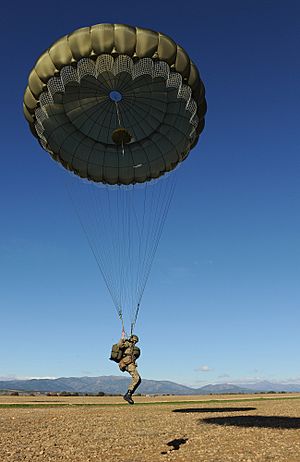Paratrooper facts for kids

Paratroopers are special soldiers. They are trained to jump from aeroplanes using parachutes. These soldiers are part of an airborne force. When paratroopers jump from the sky, it's called a paradrop operation.
Contents
History of Paratroopers
The idea of dropping soldiers from the sky is very old. Benjamin Franklin once thought about dropping soldiers from balloons with parachutes. This idea wasn't very practical back then.
But when aeroplanes were invented during World War I, it became possible. Now, soldiers could actually jump from the sky.
Early Airborne Forces
Italy was the first country to create airborne forces in the 1930s. Germany and the Soviet Union soon started their own. Germany was the first to use paratroopers in a real fight. Their paratroopers were called Fallschirmjäger, which means "parachute ranger" in German.
They used paratroopers in World War II in 1940. German paratroopers jumped into the Netherlands, Belgium, Denmark, and Norway.
Paratroopers in World War II
The United Kingdom started its own airborne forces in 1941. Their first paradrop was a surprise attack on a water line in Italy.
In 1941, Germany launched a huge paradrop in Crete. They captured the island from the British. But the British fought very hard. The German paratroopers suffered many casualties (dead and wounded). Because of this, Adolf Hitler stopped all future large paradrop operations.
When the United States joined the war, they also created airborne forces. American paratroopers jumped in North Africa, Sicily, Italy, France, and Germany.
Major Paradrop Operations
One of the biggest paradrop operations was during the Normandy invasion on June 6, 1944. The British dropped one division of paratroopers. The Americans dropped two divisions. Their job was to capture important bridges and roads in Normandy, France.
The largest paradrop ever was Operation Market Garden in September 1944. This operation helped free Belgium. It also helped capture important ports near the Rhine river.
The last big paradrop in World War II was Operation Varsity. This operation helped secure crossings over the Rhine river. It also opened roads into Germany.
After World War II
After the war, helicopters became common. Helicopters could quickly carry and land troops anywhere. This meant there was less need for very large paradrop operations. The last big paradrop was during the Suez Crisis in 1951. British paratroopers jumped at Suez.
Paratrooper Troops
Paratroopers are considered elite troops in armies worldwide. This means they are among the best and most skilled soldiers. They work as light infantry, which means they move quickly and carry lighter gear.
Training and Skills
Paratroopers get extremely tough and good training. They learn to run, fight, and carry weapons. They also learn to move and survive in very difficult places and conditions.
All paratroopers are always volunteers. To become a paratrooper, a soldier must be very fit. They also need to be very smart and have strong discipline. And, of course, they need enough courage to jump from an aeroplane!
Paratrooper Missions
In modern warfare, paratroopers are often used as rangers. A ranger is a soldier who works far from their main base. They often operate behind enemy lines.
Their main jobs include:
- Capturing important bridges, buildings, or villages.
- Carrying out guerrilla attacks, like blowing up an enemy railway line.
- Capturing enemy leaders or important soldiers.
- Doing long-range reconnaissance. This means scouting and gathering information about enemy troops and their movements.
Paratrooper Operations
Paratroopers are dropped from an aeroplane or helicopter. They land at a specific place where they need to work. This place is called a drop zone (DZ).
The Jump
Paratroopers usually jump from heights of 100 to 400 meters (about 330 to 1,300 feet). They often use round, "bell" shaped parachutes. They use a system called static line deployment. (You can learn more about this in the Parachute article.)
They usually carry pistols and rifles with them. Other weapons and gear are dropped in special containers at the same time.
After Landing
Once paratroopers land, they quickly take off their parachute gear. Then, they gather at special meeting areas with their leaders. The leaders give them orders. For example, "Capture that bridge, place dynamite there, and blow it up so the enemy can't use it."
After paratroopers finish their mission, they usually do one of two things. They might wait for their own army to arrive and take over. Or, they might travel back to their own lines. They can do this on foot, on skis, or even by stealing a car.
Famous Paratrooper Units
Many paratrooper units have special nicknames. For example, the British paratroopers are called "Red Devils." American units are known as "Screaming Eagles" and "All American." German paratroopers are sometimes called "Green Devils."
Images for kids
-
Paratroopers of the armies of Britain, Italy and the United States during an exercise in Pordenone, Italy, 2019
-
U.S. Army paratroopers with the 82nd Airborne Division parachute from a C-130 Hercules aircraft during Operation Toy Drop 2007 at Pope Air Force Base
-
Members of the 1st Marine Infantry Parachute Regiment during the Second World War, (Free French SAS).
-
VBL (armoured light vehicle) of the 1st Parachute Hussar Regiment in Afghanistan.
-
Image representing a U.S. paratrooper at Fort Belvoir, Virginia. Likely ca. 1940–1945
See also
 In Spanish: Paracaidista militar para niños
In Spanish: Paracaidista militar para niños





















